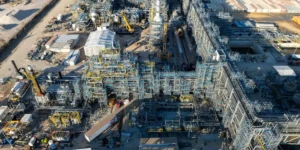GridTECH Connect Forum – Southeast tackles timely interconnection conversations


(A crowd of people pack the Orange County Convention Center’s West Hall for GridTECH Connect Forum – Southeast on Monday, February 26, 2024.)
Florida Power and Light Executive Director Crystal Stiles urges attendees not to miss “this GridTECH moment”
(Orlando, FL) – Interconnection is one of the greatest challenges standing in the way of our clean energy goals, but collaboration begets progress.
Ahead of DISTRIBUTECH International in Orlando, the interconnection conference GridTECH Connect Forum convened for the third time to tackle some of the toughest topics surrounding connecting renewable energy projects to the grid.
“How can we be more efficient with distribution level interconnections?” challenged one of Monday’s keynote speakers, Reagan Farr, President and Chief Executive Officer of Silicon Ranch. “I’m so glad we’re having this timely conversation.”
GridTECH Connect Forum – Southeast attracted more than 700 registrants and 500 attendees. Those figures represent massive growth, more than 275% year-to-year when compared to its inaugural event in California. The engaged audience also proved an appetite for interconnection in the Southeast, despite Florida’s vertically integrated utility markets offering little distinction between the distribution and transmission grids.
GridTECH Connect Forum’s next stop? Newport Beach, California June 24-26. If you want to be a part of the event in any way, don’t hesitate to reach out.

“Customers are used to having a one-way relationship with energy,” explained the other half of the keynote program Crystal Stiles, who is Florida Power and Light’s Executive Director of development, technologies, and mobility. “And one I bet they took for granted, especially if the lights always came on.”
That’s changing, though. In the not-so-distant future, many consumers will also be energy generators, pulling from and pushing back to the grid in a dynamic way. There are already around nine million DERs deployed, and more grid-edge resources are coming online at a rapid rate. Through 2023, demand-side resources accounted for more than 356 GW of capacity. Woods Mackenzie suggests the U.S. DER market will nearly double from 2022 to 2027, eclipsing $68 billion per year.
With DERs come complexities; novel technological implications and unfamiliar ways in which customers can interact with the grid. Since reliability has always been the primary focus of utilities, behind-the-meter resources fundamentally change FPL’s role.
“It’s no longer enough to deliver power reliably,” suggested Farr. “Today we are thinking about everything from efficiency and management to customers actively participating.”
“As our customers become a more integral part of this ecosystem, their needs are number one,” she added. “We need systems to adapt and know where we are going.”

Farr’s Silicon Ranch owns and operates projects in more than a dozen states. He’s had the chance to work with grid operators of all ilks and sees plenty of room for improvement.
“There’s not a single region that I look at and think- wow, they’ve really got it figured out,” he explained. Farr challenged the room to be more efficient with distribution-level interconnections, suggesting we break apart how we look at interconnection.
“There is a tremendous opportunity to further promote solar by being able to locate in smaller communities that don’t have the transmission structure and in areas like big cities that can’t do it without distributed energy resources,” Farr said.
Farr identified long interconnection queues and navigating permitting as two of Silicon Ranch’s largest challenges. That observation likely rang true to most of those in attendance. He noted that solar and storage, when developed responsibly, are still very attractive investments. Developers can make for good neighbors who support the tax base of a community while making it more carbon-neutral.
“There is a real lack of coordination between all the stakeholders in this space,” the President of Silicon Ranch continued. “The industry has really bifurcated itself, and I think sometimes we need to really focus on the projects that work and weed out the ones cluttering the interconnection queue that don’t really have a path to full construction.”
For Stiles and FPL, DER growth comes with opportunity. “We are a company filled with innovators,” she beamed, referencing a handful of pilot projects including microgrids, EV school buses, and another that incentivizes customers to charge during off-peak. FPL is also taking charging solutions on the road via mobile fast-charging trailers.
“The grid is centralized, distributed, and now it’s mobile!” Stiles laughed. “And this is just the beginning.”
“None of this could have been done without partnerships, including the ones forged here in this GridTECH moment,” she continued. “We are really excited about the future when DER and grid edge become an even bigger focus.”
Join us at GridTECH Connect California, taking place June 24-26, 2024, in Newport Beach, CA! With some of the most ambitious sustainability and clean energy goals in the country, California is at the cutting edge of the energy transition while confronting its most cumbersome roadblocks. From electrical vehicles to battery storage, microgrids, community solar, and everything in between, attendees will collaborate to advance interconnection procedures and policies in California.




